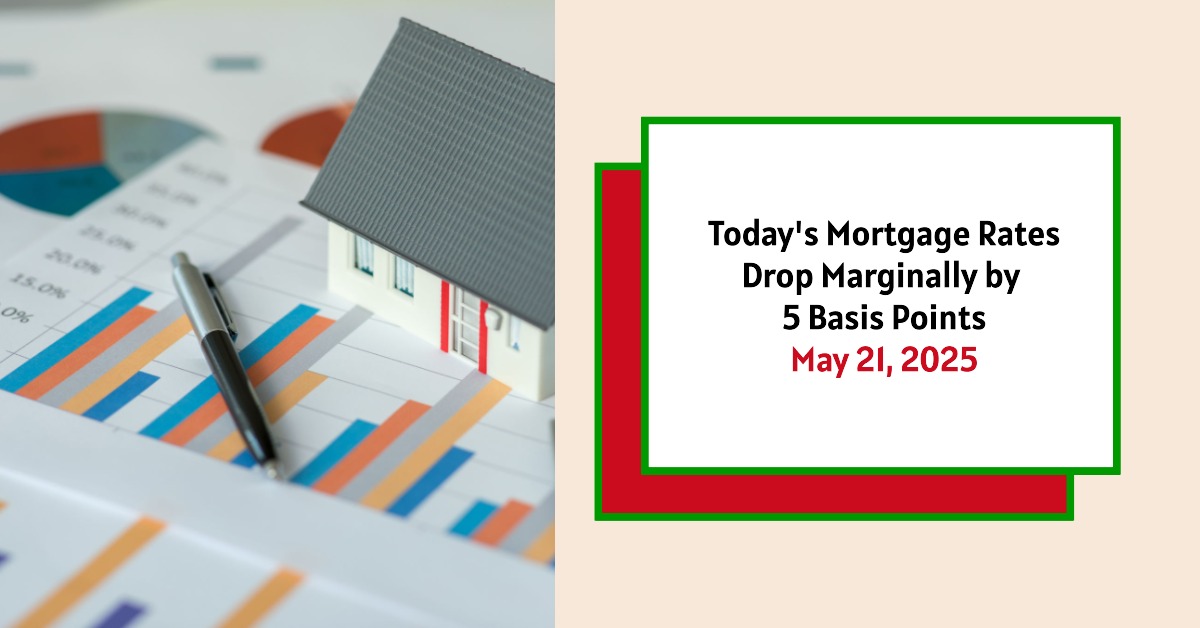As of May 21, 2025, mortgage rates have eased lower compared to previous weeks, driven by shifting economic signals and Federal Reserve policies. The average rates for key mortgage terms today are as follows: the 30-year fixed mortgage rate is sitting at 6.80%, while the 15-year fixed rate has increased slightly to 6.08%. For those considering refinancing, the 30-year refinance rate is at 6.86%. This slight decrease in mortgage rates indicates a momentary relief for potential homebuyers and those looking to refinance, even as the Fed signals delays in potential rate cuts.
Today's Mortgage Rates – May 21, 2025: Rates Go Down, But Only Marginally
Key Takeaways:
- Current Rates:
- 30-Year Fixed: 6.80%
- 15-Year Fixed: 6.08%
- 30-Year Refinance: 6.86%
- Trend: Mortgage rates have decreased slightly despite economic uncertainty and Federal Reserve predictions of delayed rate cuts.
- Forecast: There's an expectation that rates may continue to fluctuate based on economic signals, including inflation and labor market conditions.
Understanding today's mortgage rates is essential for homebuyers and those considering refinancing. The mortgage landscape can be quite complicated, but grasping how rates work can significantly influence financial decisions. Here’s an in-depth look at today’s mortgage and refinance rates.
Today's Mortgage Rates Breakdown
Let's take a detailed look at the current mortgage rates across various loan types, as reported by Zillow.
| Mortgage Type | Current Rate | Change from Previous Week |
|---|---|---|
| 30-Year Fixed | 6.80% | -0.05% |
| 20-Year Fixed | 6.37% | -0.07% |
| 15-Year Fixed | 6.08% | +0.01% |
| 5/1 Adjustable Rate | 6.98% | -0.02% |
| 7/1 Adjustable Rate | 7.15% | -0.01% |
| 30-Year VA | 6.32% | -0.03% |
| 15-Year VA | 5.71% | -0.04% |
| 5/1 VA | 6.16% | -0.02% |
The data presented here illustrates national averages and can vary by location, creditworthiness, and loan specifics.
Mortgage Refinance Rates
For those thinking about refinancing, the current statistics are as follows:
| Refinance Type | Current Rate | Change from Previous Week |
|---|---|---|
| 30-Year Fixed | 6.86% | -0.05% |
| 20-Year Fixed | 6.91% | -0.04% |
| 15-Year Fixed | 6.12% | +0.01% |
| 5/1 Adjustable Rate | 7.65% | +0.01% |
| 7/1 Adjustable Rate | 6.98% | -0.02% |
| 30-Year VA | 6.47% | -0.03% |
| 15-Year VA | 6.12% | +0.00% |
| 5/1 VA | 6.33% | +0.01% |
Mortgage refinance rates often trend higher than purchasing rates due to various market dynamics.
The Economic Context
The Federal Reserve has indicated that they are cautious about significantly cutting interest rates in the short term. According to Zillow reporter Hal Bundrick, the Fed's lack of urgency to lower rates stems from mixed economic signals and ongoing concerns about inflation. As multiple Fed speakers recently communicated, rate cuts are currently not on the agenda.
The bond market has remained somewhat steady, which can impact mortgage rates. While the current trend shows a perhaps temporary decrease in fixed mortgage rates, it's essential for potential borrowers to consider the broader economic picture when making decisions.
Comparing Mortgage Types: Fixed vs. Adjustable Rates
When selecting the right mortgage type, borrowers should weigh the options between fixed-rate and adjustable-rate mortgages (ARMs).
Fixed-Rate Mortgages
Advantages:
- Stability: Fixed-rate mortgages, particularly the 30-year option, offer predictable monthly payments. The inability for rates to fluctuate annually provides borrowers with a consistent budget.
- Lower Monthly Payments: Due to the longer repayment term, monthly payments tend to be lower than shorter fixed-rate mortgages.
Disadvantages:
- Higher Interest Rates: 30-year fixed mortgages generally have higher rates compared to shorter-term loans, leading to more interest paid over the life of the loan.
Adjustable-Rate Mortgages (ARMs)
Advantages:
- Introductory Low Rates: Initially, ARMs offer lower interest rates than fixed mortgages, enabling potential savings for borrowers in the short term.
Disadvantages:
- Uncertainty Post-Introductory Period: Rates can increase after the initial fixed period, leading to unpredictability in monthly payments.
As you can see, the choice between fixed and adjustable rates largely depends on an individual's financial situation and risk tolerance.
The Role of the Federal Reserve and Economic Indicators
Understanding the actions of the Federal Reserve (the Fed) is crucial when discussing mortgage rates. The Fed influences economic conditions through monetary policies and interest rate adjustments. If economic conditions show signs of a recession, the Fed often lowers rates to stimulate borrowing and investment. However, when inflation is a primary concern, as it is now, the Fed may opt to maintain higher rates to stabilize prices.
Current Economic Indicators Affecting Mortgage Rates:
- Inflation Rates: High inflation rates often lead to higher mortgage rates as lenders account for the decrease in purchasing power over time.
- Labor Market Data: The job market's health can influence consumer confidence and spending, ultimately affecting housing demand. If unemployment starts rising, it may spur lower mortgage rates.
- Consumer Confidence Index: Consumer trust in economic stability can impact housing market activity; higher confidence often correlates with increased home buying.
Market Predictions for Later in 2025
While today's mortgage rates are currently on the decline, market dynamics could shift based on evolving economic indicators. Predictions for mortgage rates through 2025 show uncertainty. According to industry forecasts from Fannie Mae and the Mortgage Bankers Association, the trend may include gradual decreases in overall rates, with averages expected to sit around 6.5% to 7.0% for different quarters.
This speculation is tied to many factors, including the overall health of the labor market, inflation, and economic growth projections. Fluctuations could occur, so it’s critical for buyers to stay informed by continually checking with lenders and national averages.
| Forecaster | Q2/25 | Q3/25 | Q4/25 | Q1/26 |
|---|---|---|---|---|
| Fannie Mae | 6.5% | 6.3% | 6.2% | 6.1% |
| Mortgage Bankers Assoc | 7.0% | 6.8% | 6.7% | 6.6% |
These projections can guide prospective homebuyers and investors but should be taken as general trends rather than definitive outcomes.
Frequently Asked Questions (FAQs) About Today's Mortgage Rates
- What is the national average 30-year mortgage rate right now? The current average for a 30-year mortgage rate is 6.80%, as reported by various financial analysts.
- Are interest rates expected to go down soon? Expectations indicate that rates may decline slightly in the coming months based on economic developments, but significant changes are not anticipated.
- Why are refinance rates generally higher than purchase rates? Refinancing rates are influenced by market conditions and risk assessment, often leading to slightly higher averages than those found in initial home-buying scenarios.
The Impact of Housing Supply and Demand
Beyond just interest rates, housing supply and demand play a significant role in determining mortgage rates and market trends. A tight housing supply can drive up prices and, consequently, demand for mortgages. Even if interest rates decrease, high prices can still deter potential buyers.
Additionally, new construction and inventory levels can fluctuate based on economic conditions. If the housing market sees an increase in housing starts and develops more properties, the increased supply can help stabilize or even lower housing prices, thus impacting mortgage rates indirectly.
Read More:
Mortgage Rates Trends as of May 20, 2025
Dave Ramsey Predicts Mortgage Rates Will Probably Drop Soon in 2025
Future of Mortgage Rates Post-Fed Decision: Will Rates Drop?
Fed's Decision Signals Mortgage Rates Won't Go Down Significantly
Strategies for Borrowers
In conjunction with understanding rates and macroeconomic conditions, borrowers should be strategic about their choices:
- Shop Around: Different lenders offer varying rates, so checking with multiple sources can help you find the best deal. Online tools and calculators can assist in comparing rates effectively.
- Improve Your Credit Score: A higher credit score often translates to better mortgage rates. Ensuring timely payments and keeping debt levels manageable can help improve your score over time.
- Consider Loan Terms: Weighing the advantages of longer versus shorter loan terms can impact your overall borrowing cost. While 30-year loans provide lower monthly payments, a 15-year loan can save significant amounts on interest in the long run.
Utilizing Technology in the Mortgage Process
In today's digital age, many tools and resources can make the mortgage process more efficient and transparent. Utilizing online calculators can help borrowers estimate monthly payments based on different interest rates, which can aid in budgeting and planning. Additionally, resources like financial apps can provide ongoing monitoring of interest rates and help borrowers lock in favorable terms quickly.
While the mortgage rate landscape can seem daunting, staying informed about current rates and economic factors significantly aids in making decisions. The rates today reflect slight declines, which can provide relief to borrowers amidst an uncertain economic backdrop. However, with potential fluctuations on the horizon, it’s essential to remain vigilant and responsive to market changes.
Engaging with local real estate professionals and especially mortgage brokers can also ensure that you receive tailored advice depending on your circumstances. As the market continues to evolve, having a network of expert insights will prove invaluable for making informed financial decisions.
Invest Smarter in a High-Rate Environment
With mortgage rates remaining elevated this year, it's more important than ever to focus on cash-flowing investment properties in strong rental markets.
Norada helps investors like you identify turnkey real estate deals that deliver predictable returns—even when borrowing costs are high.
HOT NEW LISTINGS JUST ADDED!
Connect with a Norada investment counselor today (No Obligation):
(800) 611-3060
Also Read:
- Will Mortgage Rates Go Down in 2025: Morgan Stanley's Forecast
- Expect High Mortgage Rates Until 2026: Fannie Mae's 2-Year Forecast
- Mortgage Rate Predictions 2025 from 4 Leading Housing Experts
- Mortgage Rates Forecast for the Next 3 Years: 2025 to 2027
- 30-Year Mortgage Rate Forecast for the Next 5 Years
- 15-Year Mortgage Rate Forecast for the Next 5 Years
- Why Are Mortgage Rates Going Up in 2025: Will Rates Drop?
- Why Are Mortgage Rates So High and Predictions for 2025
- Will Mortgage Rates Ever Be 3% Again in the Future?
- Mortgage Rates Predictions for Next 2 Years
- Mortgage Rate Predictions for Next 5 Years
- Mortgage Rate Predictions: Why 2% and 3% Rates are Out of Reach
- How Lower Mortgage Rates Can Save You Thousands?
- How to Get a Low Mortgage Interest Rate?
- Will Mortgage Rates Ever Be 4% Again?



